
Scorcher’s Still On Fire


US Congress isn’t usually able to agree on much of anything but it looks like the legislative branch has found one thing that Democrats and Republicans won’t fight about: Hip-hop is universal. This November has been declared the inaugural Hip-Hop History Month thanks to a resolution (331) co-sponsored by New York Congressman Jamal Brown and California Congresswoman Maxine Waters. The language of the resolution was reviewed by the Universal Hip-Hop Museum Founder and President Rocky Bucano. UHHM is launching its “Know Ya Hop” campaign to commemorate the occasion.
In a statement from UHHM, Bucano explained his involvement, saying, “Back in July, I was asked by Congressman Jamaal Bowman to help review the language being used to create the Resolution designating August 11th as Hip-Hop Recognition Day and November as Hip-Hop History Month. Little did we know it would pass!”
Congressman Bowman also elaborated on his commitment to the resolution, recalling, “Hip Hop is my life. Hip-Hop saved my life. Hip-Hop gave me knowledge of self. Hip-Hop is who I am. The celebration of Hip-Hop history and the study of it is essential to our democracy, our innovation, our voice, and who we are as human beings. Hip Hop is an honest story of communities around the world and provides the opportunity to increase understanding and create a pathway forward for all of us.”

Hip-hop is dominating the music industry. A new study has revealed the top fifty best-performing albums of 2021, and rap is showing it’s presence. Hip-Hop Dominates Top 50 Country singer Morgan Whalen and pop newcomer Olivia Rodrigo occupy one and two, while the late Pop Smoke’s Shoot For The Stars, Aim For The Moon sits […]

Hip-hop fans will be turning up this month. The United States Senate has passed a bill declaring August 11 as “Hip Hop Celebration Day”. Senate Passes “Hip Hop Celebration Day” Bill America’s government is officially recognizing the genre, which is now the most popular type of music in the country, with it’s own day. They […]

Since its formation in the early 1970s, hip-hop has grown exponentially, becoming one of the biggest genres in the world. This year alone a total of ten hip-hop albums have reached No. 1 on the Billboard chart this year — the most across any genre. So it’s no surprise that the Senate decided to grant hip-hop its own official holiday.
By unanimous consent, the Senate passed S.Res.331 (A resolution designating August 11, 2021, as ‘‘Hip Hop Celebration Day’’, designating August 2021 as ‘‘Hip Hop Recognition Month’’, and designating November 2021 as ‘‘Hip Hop History Month’’)
— Senate Periodicals (@SenatePPG) July 30, 2021
Less than a month before hip-hop turns 48, the United States Senate passed a resolution that recognized August 11 as National Hip Hop Celebration Day. The resolution also made August “Hip Hop Recognition Month” and November “Hip Hop History Month.” The news was shared via a tweet on the official Senate Periodicals page, which also revealed that the vote was passed with “unanimous consent.” This also marks the first time that hip-hop has been recognized in any fashion by the Senate.
August 11 is an extremely important date in hip-hop’s culture, as it serves as the day in 1973 that DJ Kool Herc, born Clive Campbell, and his sister Cindy Campbell held a back-to-school party at 1520 Sedgwick Avenue in Bronx, New York. It’s this party that many have claimed as the birth of hip-hop’s music and culture.
You can view the announcement from Senate in the tweet above.

The early ’90s might have been hip-hop’s golden era but thirty years later it’s apparent we’re entering a pretty special time for the genre. As much fuss as algorithmically generated tracklists have caused over the past couple of years, the current hip-hop landscape has been more diverse, creative, and boundless than that early time when the genre was seemingly recreated with every new release.
In 2021 especially, rappers have gotten out of their comfort zones, leaving behind familiar styles and sounds to forge new paths based not on what might sell or what the cool kids are doing, but on their own whims, fantasies, and newfound levels of access. Rappers like IDK, Tyler The Creator, and Vince Staples have always worked on the side of the field just left of center, but this year, they’ve all put out music that sounds effortlessly innovative, leaving behind the bombastic sounds that made them critical darlings to take creative risks — risks that have paid off, delivering some of their best output to date.
For IDK, that innovation came on his second album, USee4Yourself, in which he again takes a microscope to a single subject, examining it from multiple angles and drilling down to determine how he really feels about it. Whereas on his breakout mixtape IWASVERYBAD that subject was the institutionalization of Black men (especially himself) and on his debut album IsHeReal? he pondered the existence of a higher power and mourned the loss of his mom, on USee4Yourself he turns the lens to relationships and romance, filtered through his recent status as a rap star.
And while he includes frequent collaborator Rico Nasty and reaches out to the mainstream with features from Offset and Young Thug, he also burrows into his own hip-hop fandom, putting Jay Electronica and MF DOOM together on “Red.” That song also features Westside Gunn, one of rap’s modern avatar’s of bars-first hip-hop, while the production, on the whole, seems to take inspiration from Gunn’s Griselda collective rather than the brash sounds that defined IDK’s earlier projects. If anything, USee4Yourself sounds like if Yeezus was actually made by a Kanye who actually cared instead of just projecting the appearance of caring (IDK vocally sounds so much like him here, I made the personal decision to swap out all the Kanye songs on all my playlists with songs from this album).
Tyler The Creator, meanwhile, takes a different — but no less effective — tack on his new album Call Me If You Get Lost. While the production combines all of Tyler’s best eras — the soulful reinvention of Igor, the reflective pop of Cherry Bomb and Flower Boy, the abrasive rap on Goblin — the subject matter finds Tyler settling into his role as a recent Grammy winner and multimillionaire, embracing rap’s classic braggadocio in place of his former rebellious shock-rap provocations. Inviting DJ Drama onto the tape to provide hyped-up ad-libs, Ty positions the album as his own entry into the Gangsta Grillz canon.
On several tracks, including the lead single “Lumberjack,” Ty points to his Rolls-Royce, finding ever more elaborate ways to both flex and juxtapose the signifier of wealth with his social status, a la The Throne’s “N****s In Paris.” In a recent interview, Tyler cited BET as the resource that taught him everything he knows; on Call Me, he finally wears that influence on his immaculately tailored sleeve, embracing the bombast of the 2000s crunk era’s fascination with garish jewelry and unfiltered gasconade. He also gets really real about feeling rejected by Black people as much as white people on the autobiographical “Massa,” challenging the expectations against him directly rather than subverting them or simply acting out as he had in the past.
Challenging expectations and sharing the grim realities of his biography were never problems Vince Staples had. Instead, he found that his unflinching confrontation of the traumas that defined his upbringing was being swallowed up by his caustic production choices. It’s no surprise that the EDM-influenced, demented, post-apocalyptic pinball machine beats on Big Fish Theory kept people from tuning all the way into what he was saying or that the alarming screech of the “Blue Suede” instrumental washed out the track’s harrowing narratives of life in gang-divided North Long Beach.
So instead, Vince challenged himself — and frequent collaborator Kenny Beats — to make something more palatable on his self-titled latest. The beats are awash in something like nostalgia — if the word “nostalgia” could ever imply the paranoia creeping through tracks like “Are You With That?” and “Sundown Town.” The placid beats and laid-back delivery are exactly what it seems like Vince would have been doing all along were commercial considerations never a factor (one senses his prior resistance to playlist-friendly material was his own form of rebellion at the thought of being a “star”). Getting away from the crazed, frenetic production that anchored his previous projects let Vince’s voice shine through.
Even Dave East, that eternally maligned avatar of millennial New York City tribalism, has found his groove working alongside soulful producer Harry Fraud on the singles from the upcoming Hoffa. East has struggled in the past, trying to wrangle mainstream expectations with his own taste, to the point where some fans on Twitter have wondered at his inability to connect with a wider audience while artists like those on Griselda seemed to garner more support by avoiding doing the same. Employing the smooth production of Harry Fraud, Dave has never sounded more comfortable than he does on “Diamonds,” “Uncle Ric,” and “Chapo.” This is what he should have been making all along, maybe.
And that seems to be the end result of all this experimentation. Although I said rappers got out of their comfort zones, perhaps the title should read they found and got into their comfort zones. Each of the above-named artists sounds more relaxed, assertive, confident, and clear-headed than they ever have, with nothing to prove and no one to impress but themselves. In trading in their trademark production or shaking loose lyrical crutches, by embracing the tactics and beliefs they once held at arm’s length, they have tapped into a new vein of creativity. The result is a gold rush of unique, engaging, progressive hip-hop that the culture could certainly use much more of — and that fans should reward with their ears.
Some artists covered here are Warner Music artists. Uproxx is an independent subsidiary of Warner Music Group.
If you live for sneakers, skateboarding, Supreme drops, and all things hip-hop, you have late ‘80s and early ‘90s New York street culture to thank for that. And you’re probably going to love All The Streets Are Silent, a feature-length documentary debut from Jeremy Elkin that explores this still influential period of American youth culture. For the documentary, Elkin reached out to the kids (and Kids) who grew up in the scene — who better to document that golden age of style and music than the people who lived it?
Premiering today at New York’s Tribeca Film Festival as a documentary select, “All The Streets Are Silent” takes you on a deep dive into the streets of New York City, back to the days when skate culture and hip-hop were still rebellious expressions of street youth and not global commodities with rabid fan bases dominated by hype.
The film, which is narrated by Zoo York cofounder and Uproxx Style editor Eli Morgan Gesner uses archival footage and covers notable figures and locales of the era, including Harold Hunter, Club Mars, Supreme, and DJ Stretch Armstrong. The stars of the counterculture are in full effect but at its heart, All The Streets Are Silent is an examination of being a kid in New York City during a special time in pop culture. With guests like Rosario Dawson, Darryl “DMC” McDaniels, DJ Clark Kent, the late Keith Hufnagel, and Yuki Watanabe, “All The Streets Are Silent” offers an exploration of race, society, fashion, and street culture in a culturally significant era in New York City history wrapped in a Paris is Burning meets Kids aesthetic that oozes cool.
Elkin took this project seriously, in addition to linking up with Gesner, he also tapped the legendary Large Professor, the producer that brought us Tribe Called Quest’s “Keep it Rollin” to do the soundtrack. It doesn’t get more vintage New York than that. Check out the trailer for All The Streets Are Silent above and stream it on-demand until June 23rd for $15 here.

If it seems like every week a new celebrity launches a weed brand, that’s because… every… week… a new celebrity… launches… a… weed brand. For the most part, these entries into an increasingly crowded marketplace are pretty forgettable. But occasionally — as with the case of Jay-Z’s Monogram and Seth Rogen’s Houseplant — the right team manages to knock it out of the park, earning permanent shelf space at your local dispensary.
I’m pleased to say that FlowerShop — a new brand launched by rapper and producer G-Eazy, along with co-founders and fellow Bay Area boys Isaac Muwaswes and Gabe Garcia — is one of those select few. But FlowerShop isn’t just a cannabis label. It’s also a wellness company, with a long list of products on deck. Its first drop delivers rolling papers, lighters, ashtrays, and three glass-tipped pre-roll joint packs, called Bouquetpacks. A 1/8th flower jar and “cannabis juice” are coming soon.
The Bouquetpacks offer three different mood-focused strains — dubbed Comfort, Smile, and Joy — each packed in reusable plastic tubes and sporting a glass-filter tip for better handling and flavor. After smoking the Comfort strain, I spoke with Muwaswes, Garcia, and G-Eazy himself about the origins of the brand, their own relationships to cannabis, and why joints will always feel special.
But first, let’s break down the weed.
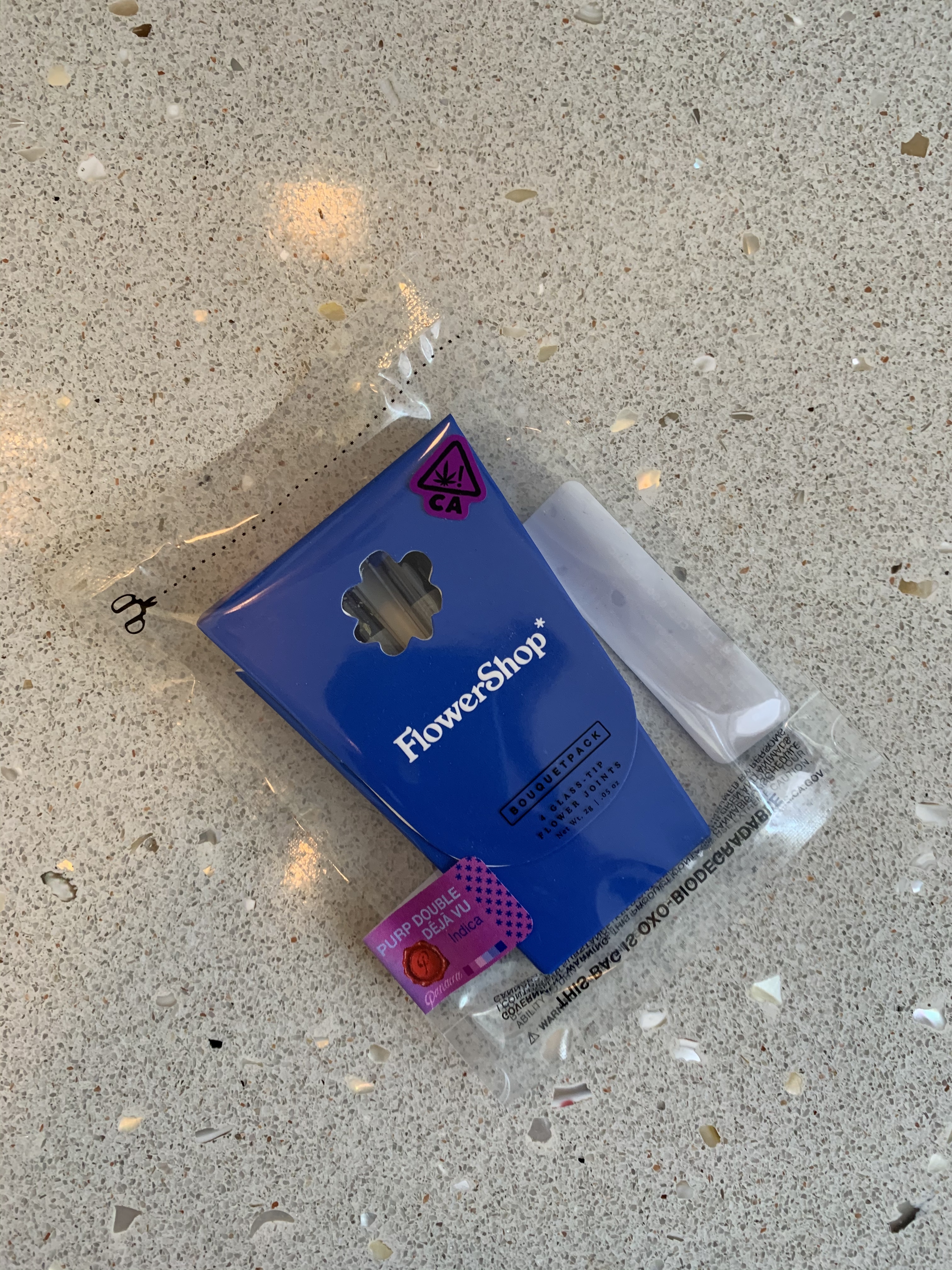
Right out of the gate, the first interesting thing about FlowerShop is the brand’s design aesthetic. The Bouquetpack’s matte flip-top box features a magnetic top, and four pre-rolled single flower joints packed in resealable plastic tubes with glass filter tips. At four joints per pack and a retail price of $50, you’re looking at a cost of $12.50 per joint.
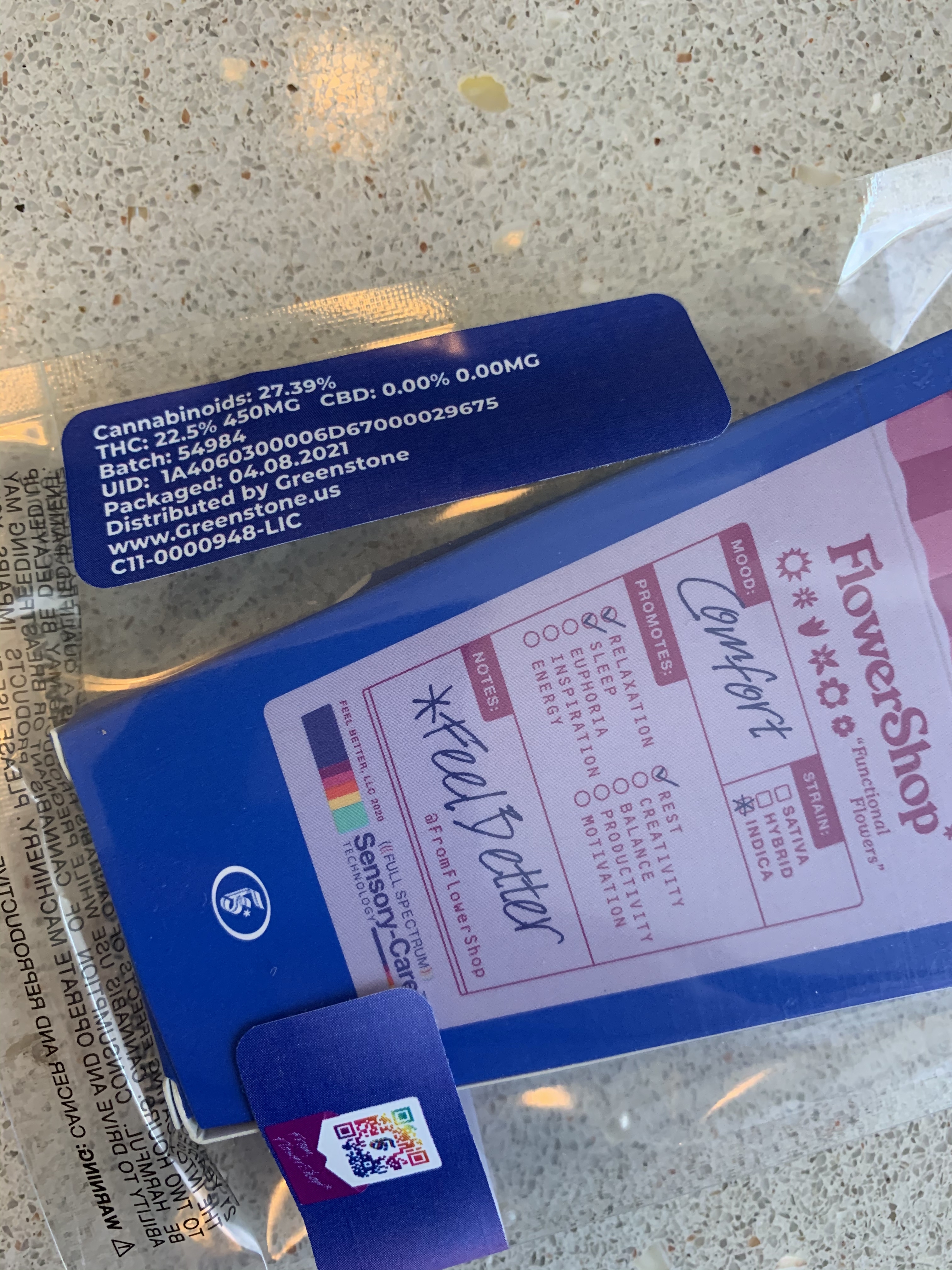
Since an eighth of Panacea Farms Purple Double Deja Vu will cost you about $60 before taxes, this pack has pretty good value for what you get, it’s a lot better than Monogram’s $60 hand-roll, for example, and the weed is of a much higher quality.
A fifth joint would’ve really set this up as something special though. The packaging is playful and colorful, but we would’ve preferred just a little bit more information for the consumer.
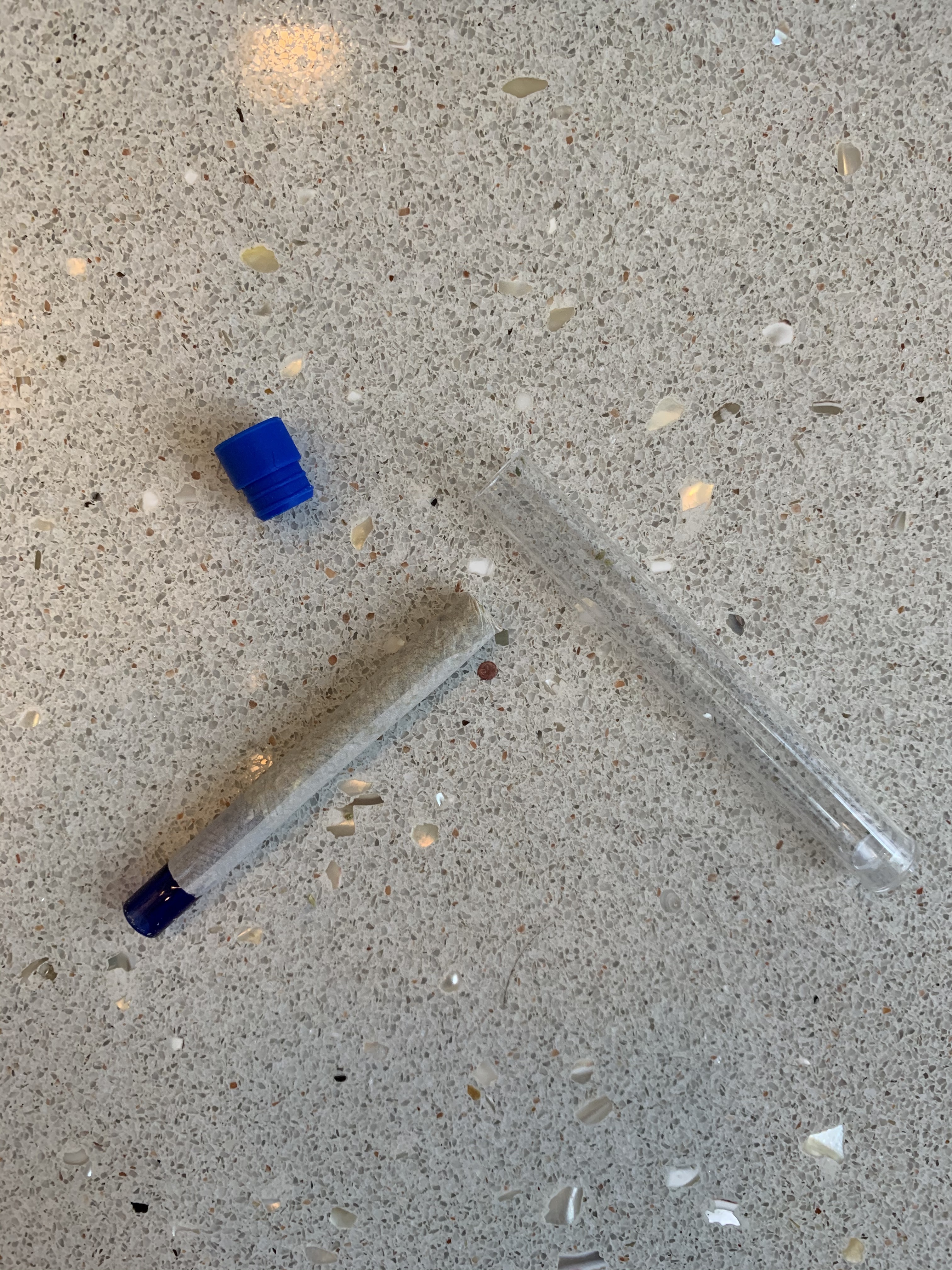
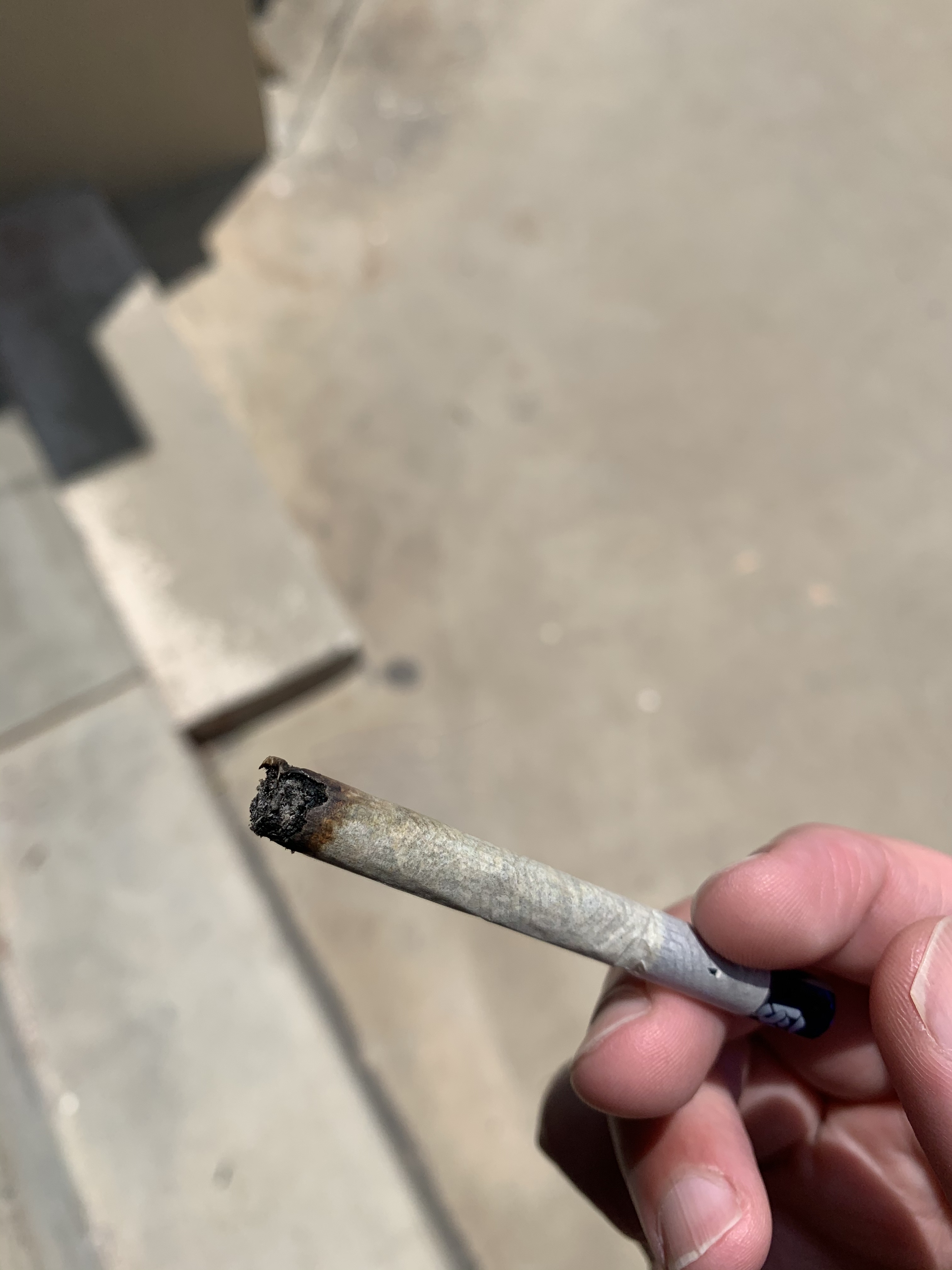
Strain: Indica
Dominant Terpenes: Caryophyllene, Myrcene, Pinene, Humulene,
THC: 22.5%
Retail Price: $50
The Experience
One of the things that first struck me about FlowerShop’s pre-roll pack was just how fragrant it smelled after I cut open the sealed plastic envelope it came packaged in. Once the scissors pierced the plastic I was instantly greeted by a wave of floral and slightly minty smells, with a slight pepper edge that tickles the nose. The joint itself is incredibly well packed, just rolling it through my fingers showed a consistent and dense pack that led to a lengthy smoke session with thick clouds of milky intoxicating smoke.
Again, FlowerShop’s attention to detail and design is at the forefront here. Each glass filter utilizes blue-colored glass — fitting with the color scheme. Does that have any effect on how high you get? Absolutely not, but it certainly has an effect on the experience. Smoking FlowerShop’s joints feels like you’re enjoying something special, it’s practically begging to be shared just so you can pass it around as a conversation piece.
Of course, cool filters would feel like a gimmick if the high didn’t deliver. It does. This will be a fun joint to pass between friends when we’re past Covid, but right now I’m not sharing with anyone. Which resulted in me getting — to borrow a Bay Area phrase — hella high.
Comfort is made using Panacea Farm’s Purple Double Deja Vu and the high comes on incredibly quickly here. Well before you make your way through the joint, a pleasing buzz took over me — beginning in the center of the forehead before melting down in radiating waves of euphoric bliss through the rest of my body. Real talk: I did not expect a celebrity-fronted weed brand to hit this hard. FlowerShop chose well by linking up with Panacea Farm for this one and opting for a single-sourced full flower joint (rather than a blend of shake) led to a better tasting, less harsh product.
I broke up one of my spare pre-rolls (which I regret) to get a look inside — Comfort has a great medium-coarse grind and the bud is fresh and still slightly sticky.
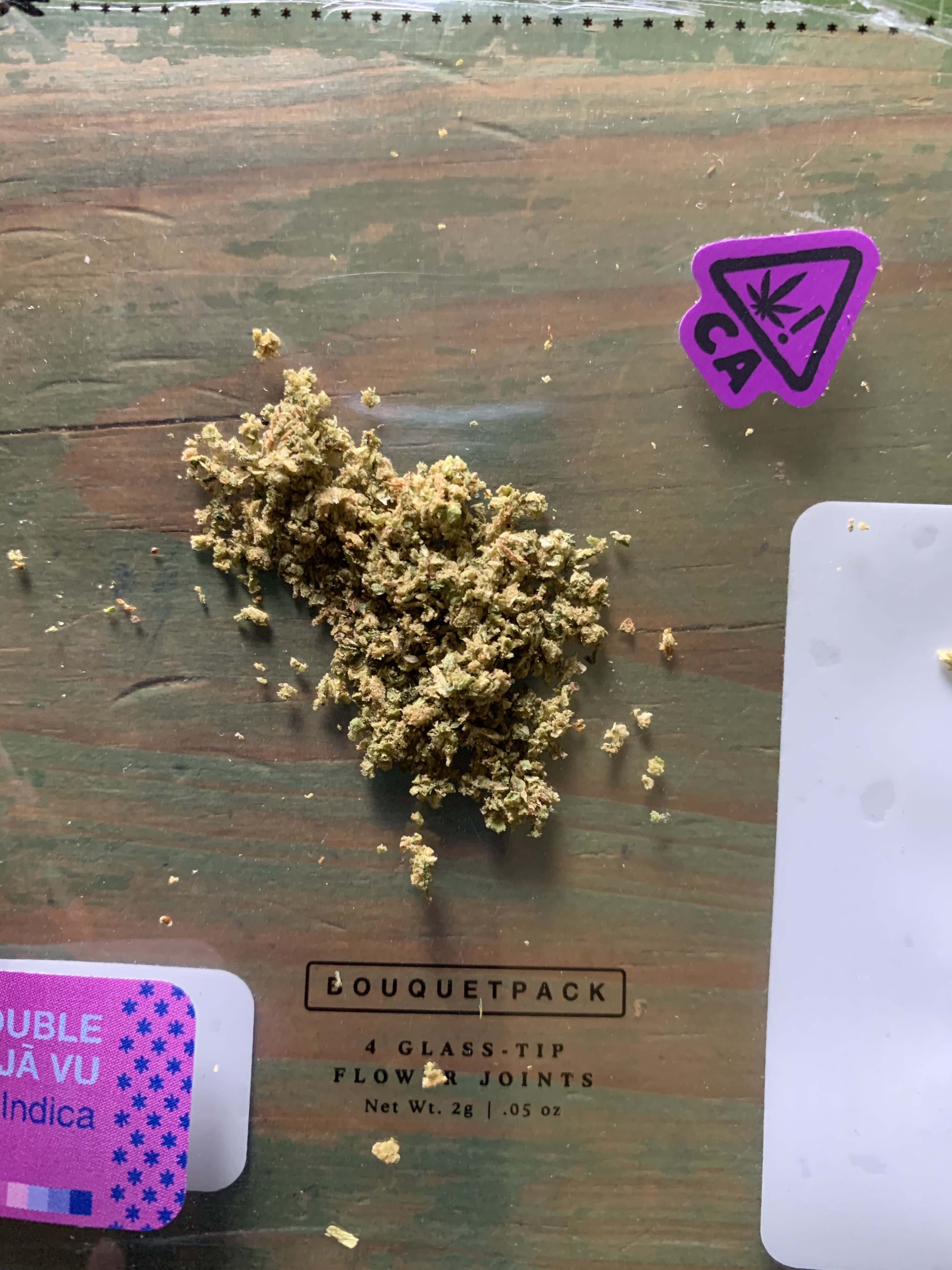
Flavor-wise, Comfort had floral notes with a heavy gas flavor and a peppery, slightly melon aftertaste. The smoke was remarkably smooth which is rare in pre-packaged joints, resulting in pleasingly smooth drags that didn’t lead to a single cough during my whole experience.
My only gripe is that calling the strain “Comfort” is a bit misleading, they might as well call it “KO” — smoking a full joint solo launched me beyond couch lock and straight into a nap. I had no plans on taking a nap, I wasn’t even tired, so this is definitely not something to mess with if you’ve got plans.
The Bottom Line
Smooth smoke with earthy flavors of cracked pepper and subtle melon and mint, which results in a body-tingling euphoric high designed to knock you out.
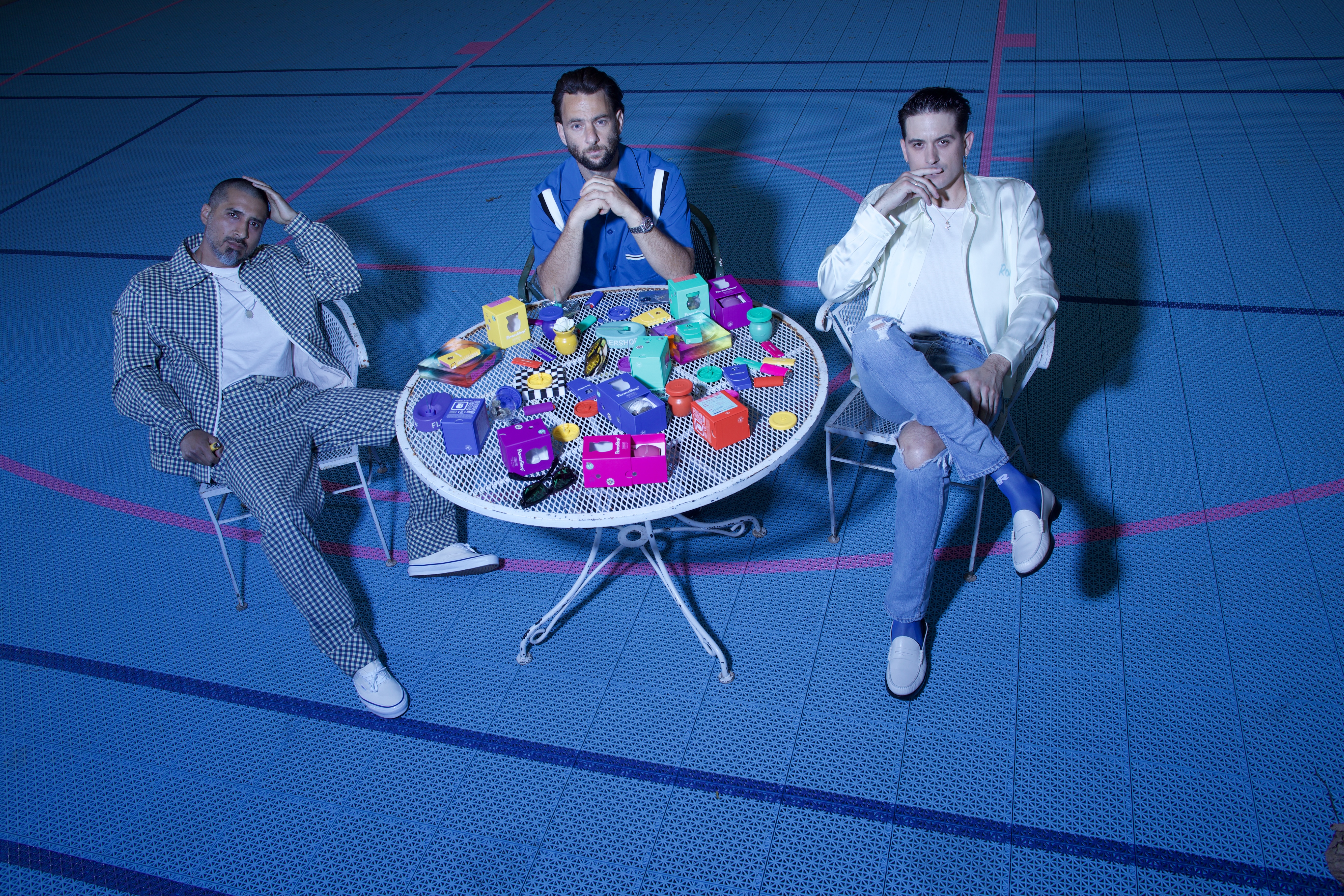
You’re all Bay Area kids, can you speak to the cannabis scene in the Bay Area while you were growing up. I know it’s always been a big part of the culture.
Muwaswes: I was born and raised in San Francisco, not too far from Haight Ashbury, so some of my early memories of being exposed to weed was going down to Haight Ashbury with my friends to kick it. As a young kid you’re kind of exposed to this narrative around the history and the demonization of cannabis, but as I kind of got into it in middle school going to high school you start to make your own assumptions.
But even then, pretty early on in high school, I started to hear about all these medicinal uses for it and hearing about the groundswell that was happening surround Prop 215. It was really being looked at as a medicine, and I’ve come across friends of my parents who were using it as a medicine as well, so pretty early on I started to see it as “oh this is something we in the Bay Area kind of have a different view upon and are really progressive on” and that intertwined with the cultural aspect, growing up listening to hip-hop, being into all things hip-hop, music, fashion — it was intertwined in those subcultures.
Whatever group of friends I had — whether it was my athlete friends, my friends into music, the friends into fashion — that was one thing we all shared. One experience that connected us all was smoking.
I know the brand takes a heavily sensory approach to cannabis, that’s right on the packaging. What’s the thinking behind positioning the brand this way and how does it differ from other celebrity-fronted brands that are springing up in the cannabis space?
Muwaswes: When we built Flower Shop we really built it as a wellness company as a whole, I think we always looked at cannabis as one aspect or one category of what we’re trying to do from the perspective of wellness. For us, we tried to really define what wellness means to us. One big realization we had was that it’s not one thing, it’s not singular, it’s more about the journey than the destination
Through that, we started to define how we can take people through that journey, and what we do to get on that journey. It’s about inspiring our senses, whether it’s the music we listen to, the candle we burn that smells a certain way, whether it’s the lighting in the room that makes us feel a certain way and opens up our mood to certain elements or experiences, we always knew it tied back to one or many of our senses and we’re already in that mindset for a lot of the other things we were doing previous to FlowerShop. Whether it was in the design world with Gabe or the music world with G, it’s about bringing all of that together in a retailer experience.
That was kind of the genesis of sensory care, and then we started to apply that to everything we were doing from product to packaging to messaging to content.
G Eazy: To jump in, from my perspective as a musician, music can be a healing agent. Similar to flower, it can be something that brings people together, people who share this commonality come together for this shared experience. But as a musician I have a wide array of influences and taste in music, I can deliver “No Limit” but then I can do “Everything Will Be OK,” that wide offering and understanding of mood and emotions are important in anything you offer because you don’t just have one customer, and each customer doesn’t have just one mindset and mood.
We wanted to find what resonates at different times of the day or different times in your life, and wanting to reach people on a level of emotion and feeling, similar to the way music would.
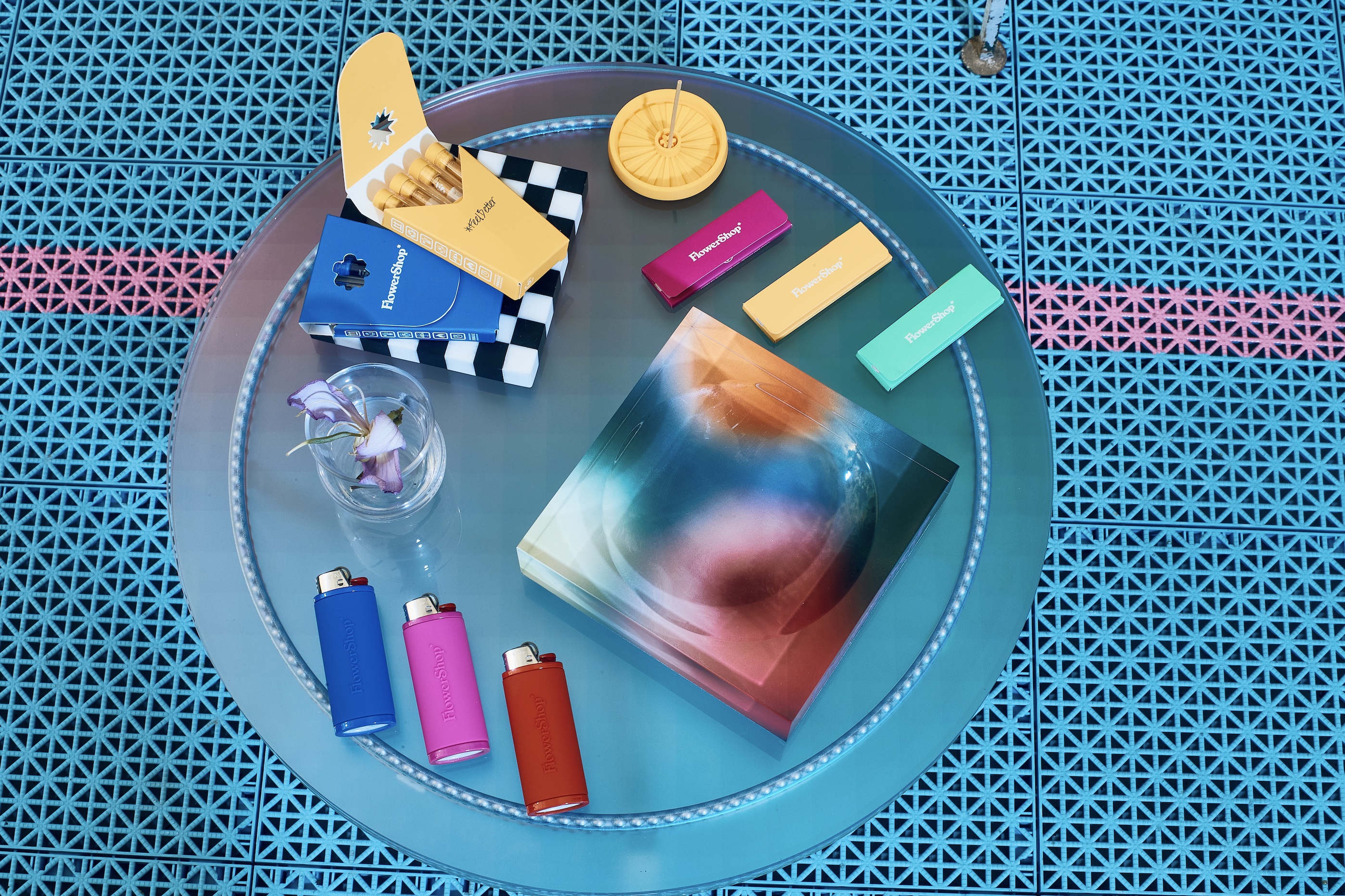
I wanted to ask you specifically about your smoking habits G, are you smoking a bowl before you hit the studio, something you do after to unwind, what’s your creative relationship with the plant?
G-Eazy: There is pretty much a constant burn in the studio. Atmosphere is huge in the creative process, that comes down to lighting, how cold I like it, the people I want and don’t want in the studio, and that comes down to what I’m drinking and smoking. With smoking, it’s not a requirement. It’s not needed to unlock creativity, but nonetheless, it’s something that loosens you up and makes you feel better and makes you feel joy or relaxation, that can only open you up and enable more flow of stream of consciousness.
Garcia: To add to that we started thinking about whether cannabis a creative performance enhancer? We like the idea, we can’t go shout it off the mountaintops, but for us, we like that conceptually and believe it. But to G’s point, it’s not a reliance.
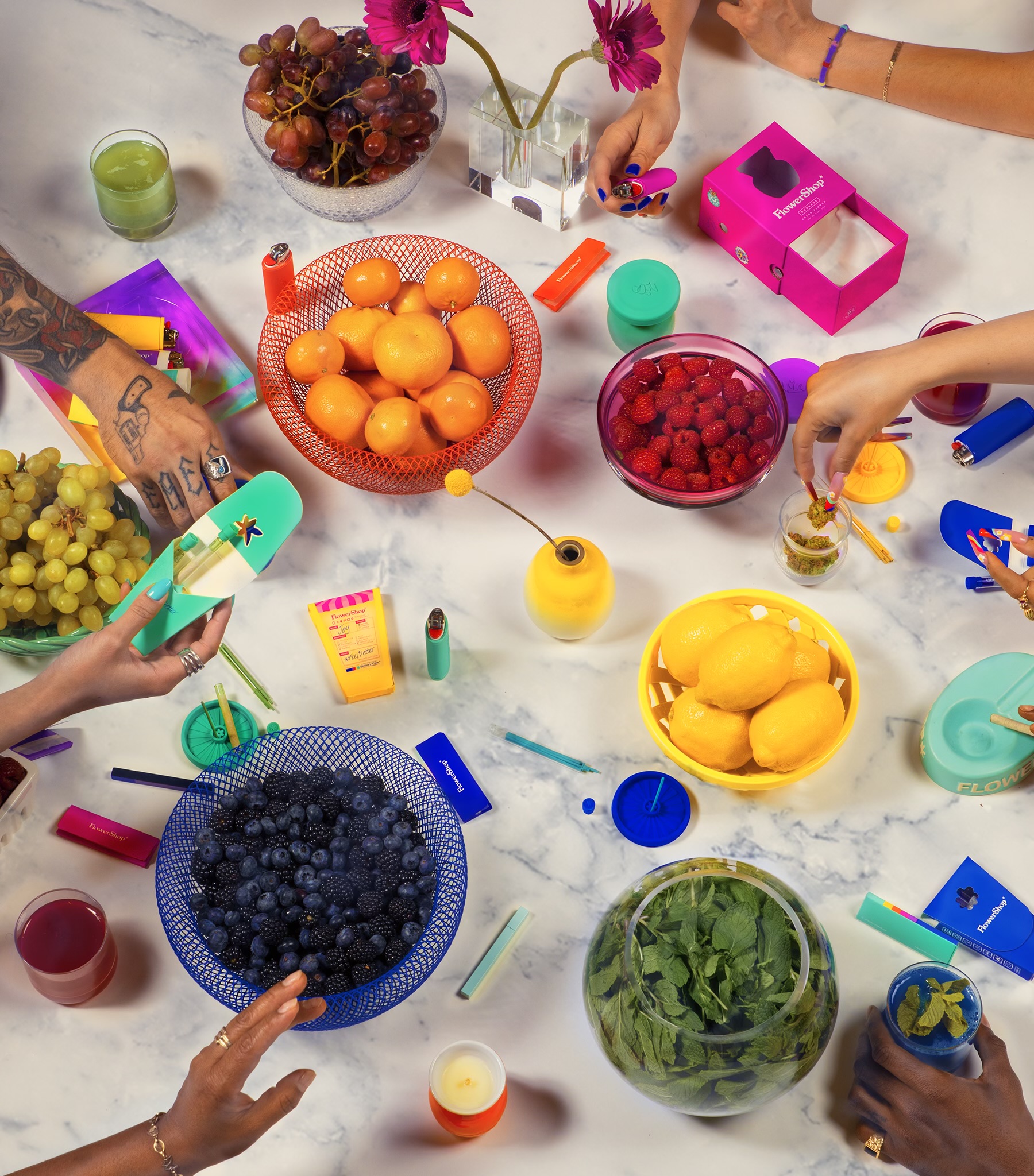
G what’s your preferred smoking method and why did you guys start with the BouquetPack over a flower jar?
G-Eazy: Joints and blunts. It’s what I grew up smoking. Every day in high school coming home from work, I’d get home around midnight or 1 AM and I’d roll up a personal blunt and smoke it in the backyard while my mom was asleep, just to be able to wind down and decompress and get ready for school the next morning. It was just culturally what I grew up doing.
Garcia: That’s the reason we’re excited to share the bouquet pack and included the glass tip pre-rolls, that’s our attempt to elevate what is standard.
Where is the product sourced from?
Muwaswes: Sourcing wise we have a number of really good relationships with cultivators throughout the entire state of California. A lot of the key growers out here we have partnerships with and what we’re doing right now is these drops or deliveries with individual strains and growers. The one you have right now, we partnered with Panacea Farms for — a craft grower under the NorCal banner. We’re doing a number of different things with brands, growers, and cultivators, long term we are going to be having our own genetics out there, but for the time being, we’re trying to find the best of the best that we want to work with that also understand our vision and understand what we’re trying to do from a sensory care perspective with these products.
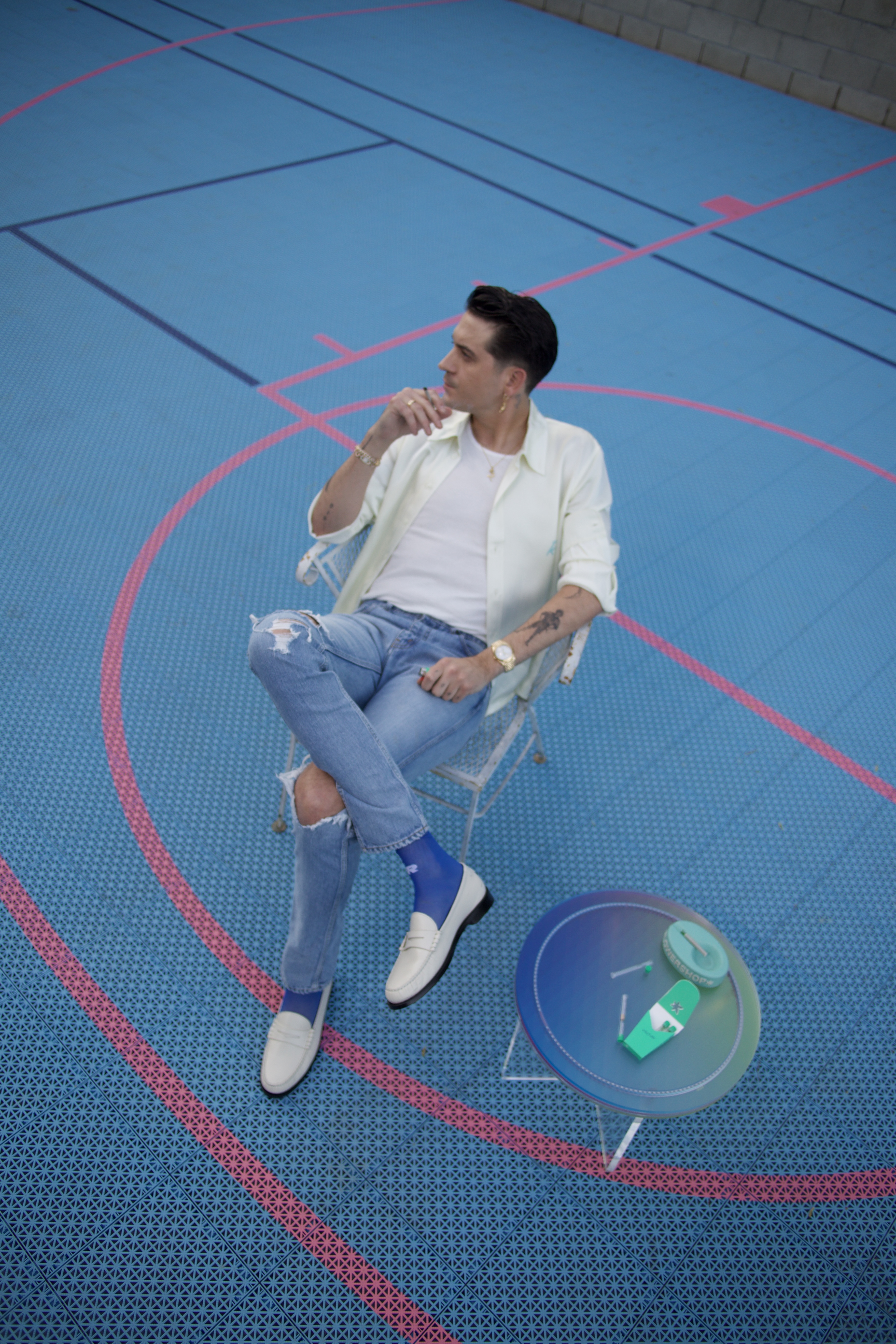
What brought you to the cannabis business? Your backgrounds are comfortably in design and music, not in the cannabis industry.
Garcia: It came to us really, growing up in the Bay Area and how prominent it is it was probably inevitable. It came through a design project at first. We’ve been in the creative design space for a long time.
We started getting inbound requests from the cannabis end, that’s how it initially started to come to us, and we entertained one specific deal and that’s where it really started. As we got into it and did the research, we wanted to find our foothold and what felt authentic to us to enter the space and it was through design, through packaging through a vision, but as we got into it, we started asking ourselves deeper questions.
This is a two-and-a-half-year project in the making and we’re really proud of it and excited to share it with the world.
What’s special about FlowerShop, what sets it apart from other brands?
Garcia: It’s all in our packaging! We really did our best to make it as recyclable and eco-conscious as possible. We tried to make everything reusable — or unique enough to make people want to reuse it. The tubes the pre-rolls come in, our incense sticks are coming in those, it’s also a tube you can use to clean your glass tips and reuse them, same thing for the box itself.
Our Bud Vase, which will be dropping in 90 days, has a jar that’s able to be reused. With all of our packaging, we’ve thought about how we can inspire people to reuse it and reapply it to something else. The vase is food grade, it can be washed in the dishwasher, it can be used to store yogurt —
G-Eazy: As a shot glass!
Garcia: You know it!
Muwaswes: We were just as focused on what was going into the packaging as who we are sourcing weed from. Using a single strain indoor for our prerolls, not using shake, grinding the best of the best, being meticulous about the grind and the coarseness, consistency on the burn and smoke, even on the sourcing of the paper!